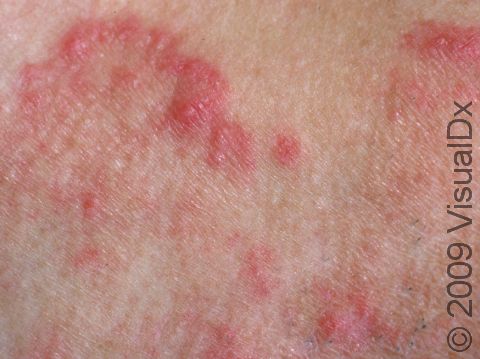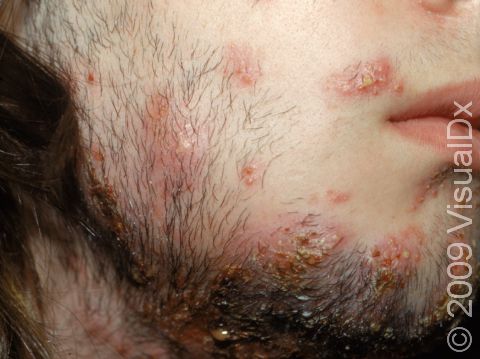Ringworm, Beard (Tinea Barbae)
Tinea infections are commonly called ringworm, though there is no worm, because the rash, which is caused by a fungus, forms a pattern that resembles a ring with an outer scaly circle. Tinea barbae is an infection that specifically affects the part of the face that is usually shaven, known as the beard distribution. Beard ringworm is contagious and is passed from person to person, animal to person, and from contaminated objects (such as towels and pillows) to person. It would be possible for beard ringworm in one person to be passed as a facial, body, or scalp ringworm in another person because all the infections are caused by the same fungi.
Who's At Risk?
Almost anyone with facial hair can get beard ringworm, though it is most commonly seen in men who shave and in women who have coarse facial or neck hair. It also tends to occur more often in people who live in warm, humid climates and people who work with farm animals. Beard ringworm is more commonly seen in warmer, more humid climates. It is most frequently passed to humans from animals, so agricultural workers are the most commonly infected people with beard ringworm.
Signs & Symptoms
The most common locations for beard ringworm infection include the following:
- Chin
- Cheeks
- Neck
- Upper lip
Beard ringworm may affect either the outer surface (superficial) or the deep portion of the skin that holds shafts of hair (hair follicles). If the infection is superficial, beard ringworm appears as a pink-to-red scaly patch ranging in size from 1 to 5 cm. Alternatively, small pus-filled bumps (pustules) may be seen around hair follicles in the affected skin. In deeper forms of beard ringworm, you may see firm red nodules covered with pustules or scabs that may ooze blood and pus.
Beard ringworm is usually itchy. Deeper forms of beard ringworm may be accompanied by fever and swollen lymph glands.
Self-Care Guidelines
It is extremely difficult to totally get rid of beard ringworm with only topical medications; oral antifungal medications are usually required. However, if the infection has just started, you might try one of the following over-the-counter antifungal creams or lotions:
- Terbinafine
- Clotrimazole
- Miconazole
Apply the cream to each lesion and to the normal-appearing skin 2 cm beyond the border of the affected skin for at least 2 weeks until the areas are completely clear of lesions. Remember, you will probably not be able to totally get rid of the beard ringworm with topical creams.
Stop shaving the affected area until you start treatment. If you must shave, use a new disposable razor each time you shave.
Since people often have tinea infections on more than one body part, examine yourself for other ringworm infections, such as in the groin (tinea cruris), on the feet (tinea pedis, athlete’s foot), and anywhere else on the body (tinea corporis).
Have any household pets or farm animals evaluated by a veterinarian to make sure they do not have a fungal (ie, dermatophyte) infection. If the veterinarian discovers an infection, be sure to have the animal treated.
Treatments
To confirm the diagnosis of beard ringworm, your physician might scrape some surface skin material (scales) or pluck an affected hair and place it onto a glass slide for examination under a microscope. This procedure, called a KOH (potassium hydroxide) preparation, allows the doctor to look for tell-tale signs of fungal infection.
If you have many pus-filled lesions or if deeper lumps are present, your physician may wish to perform a procedure to grow out the fungus (fungal culture) in order to discover the particular organism that may be causing the infection. The procedure involves:
- Penetrating the pus-filled lesion with a needle, scalpel, or lancet.
- Rubbing a sterile cotton-tipped applicator across the skin to collect the pus.
- Sending the specimen away to a laboratory.
The fungal culture can take up to 3 weeks to produce final results.
Since beard ringworm usually requires oral antifungal pills in order to get rid of the infection completely, your physician will likely recommend one of the following oral medications:
- Terbinafine
- Itraconazole
- Griseofulvin
- Fluconazole
- Ketoconazole
Beard ringworm should go away within 4–6 weeks after using effective treatment.
Visit Urgency
If the lesions do not improve after 1 or 2 weeks of applying over-the-counter antifungal creams, see your doctor for an evaluation. If the affected areas are deep and tender or if you have a fever or swollen lymph glands, see your doctor as soon as possible.
References
Bolognia, Jean L., ed. Dermatology, pp.1174-1185. New York: Mosby, 2003.
Freedberg, Irwin M., ed. Fitzpatrick’s Dermatology in General Medicine. 6th ed. pp.1861, 1996-1997. New York: McGraw-Hill, 2003.
Last modified on August 16th, 2022 at 2:44 pm

Not sure what to look for?
Try our new Rash and Skin Condition Finder

